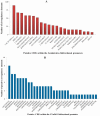Functional characterization of a bidirectional plant promoter from cotton leaf curl Burewala virus using an Agrobacterium-mediated transient assay
- PMID: 24424501
- PMCID: PMC3917440
- DOI: 10.3390/v6010223
Functional characterization of a bidirectional plant promoter from cotton leaf curl Burewala virus using an Agrobacterium-mediated transient assay
Abstract
The C1 promoter expressing the AC1 gene, and V1 promoter expressing the AV1 gene are located in opposite orientations in the large intergenic region of the Cotton leaf curl Burewala virus (CLCuBuV) genome. Agro-infiltration was used to transiently express putative promoter constructs in Nicotiana tabacum and Gossypium hirsutum leaves, which was monitored by a GUS reporter gene, and revealed that the bidirectional promoter of CLCuBuV transcriptionally regulates both the AC1 and AV1 genes. The CLCuBuV C1 gene promoter showed a strong, consistent transient expression of the reporter gene (GUS) in N. tabacum and G. hirsutum leaves and exhibited GUS activity two- to three-fold higher than the CaMV 35S promoter. The CLCuBuV bidirectional gene promoter is a nearly constitutive promoter that contains basic conserved elements. Many cis-regulatory elements (CREs) were also analyzed within the bidirectional plant promoters of CLCuBuV and closely related geminiviruses, which may be helpful in understanding the transcriptional regulation of both the virus and host plant.
Figures






Similar articles
-
Functional characterization of a strong bi-directional constitutive plant promoter isolated from cotton leaf curl Burewala virus.PLoS One. 2015 Mar 23;10(3):e0121656. doi: 10.1371/journal.pone.0121656. eCollection 2015. PLoS One. 2015. PMID: 25799504 Free PMC article.
-
Transcript mapping of Cotton leaf curl Burewala virus and its cognate betasatellite, Cotton leaf curl Multan betasatellite.Virol J. 2012 Oct 29;9:249. doi: 10.1186/1743-422X-9-249. Virol J. 2012. PMID: 23106938 Free PMC article.
-
Cotton leaf curl Burewala virus with intact or mutant transcriptional activator proteins: complexity of cotton leaf curl disease.Arch Virol. 2015 May;160(5):1219-28. doi: 10.1007/s00705-015-2384-4. Epub 2015 Mar 14. Arch Virol. 2015. PMID: 25772572
-
Dominance of resistance-breaking cotton leaf curl Burewala virus (CLCuBuV) in northwestern India.Arch Virol. 2012 May;157(5):855-68. doi: 10.1007/s00705-012-1225-y. Epub 2012 Feb 4. Arch Virol. 2012. PMID: 22307170
-
Transient expression analysis of promoters of okra enation leaf curl virus in Nicotiana benthamiana, cotton and okra plants.Virus Genes. 2024 Aug;60(4):412-422. doi: 10.1007/s11262-024-02074-7. Epub 2024 May 10. Virus Genes. 2024. PMID: 38727968
Cited by
-
Functional characterization of a strong bi-directional constitutive plant promoter isolated from cotton leaf curl Burewala virus.PLoS One. 2015 Mar 23;10(3):e0121656. doi: 10.1371/journal.pone.0121656. eCollection 2015. PLoS One. 2015. PMID: 25799504 Free PMC article.
-
Impact of cis-acting elements' frequency in transcription activity in dicot and monocot plants.3 Biotech. 2015 Dec;5(6):1007-1019. doi: 10.1007/s13205-015-0305-6. Epub 2015 May 13. 3 Biotech. 2015. PMID: 28324408 Free PMC article.
-
An Integrative Computational Approach for Identifying Cotton Host Plant MicroRNAs with Potential to Abate CLCuKoV-Bur Infection.Viruses. 2025 Mar 12;17(3):399. doi: 10.3390/v17030399. Viruses. 2025. PMID: 40143327 Free PMC article.
-
CRISPR/Cas9-Mediated Immunity to Geminiviruses: Differential Interference and Evasion.Sci Rep. 2016 May 26;6:26912. doi: 10.1038/srep26912. Sci Rep. 2016. PMID: 27225592 Free PMC article.
-
In Silico Identification of Cassava Genome-Encoded MicroRNAs with Predicted Potential for Targeting the ICMV-Kerala Begomoviral Pathogen of Cassava.Viruses. 2023 Feb 9;15(2):486. doi: 10.3390/v15020486. Viruses. 2023. PMID: 36851701 Free PMC article.
References
-
- Stanley J.B.D.M., Briddon R.W., Brown J.K., Fauquet C.M. Geminiviridae. In: Fauquet C.M., Mayo M.A., Maniloff J., Desselberger U., Ball L.A., editors. Virus Taxonomy, Viith Report of the Ictv. Elsevier/Academic Press; London, UK: 2005. pp. 301–326.
-
- Pattanaik S., Dey N., Bhattacharyya S., Maiti I.B. Isolation of full-length transcript promoter from the strawberry vein banding virus (SVBV) and expression analysis by protoplasts transient assays and in transgenic plants. Plant Sci. 2004;167:427–438. doi: 10.1016/j.plantsci.2004.04.011. - DOI
Publication types
MeSH terms
Substances
LinkOut - more resources
Full Text Sources
Other Literature Sources

